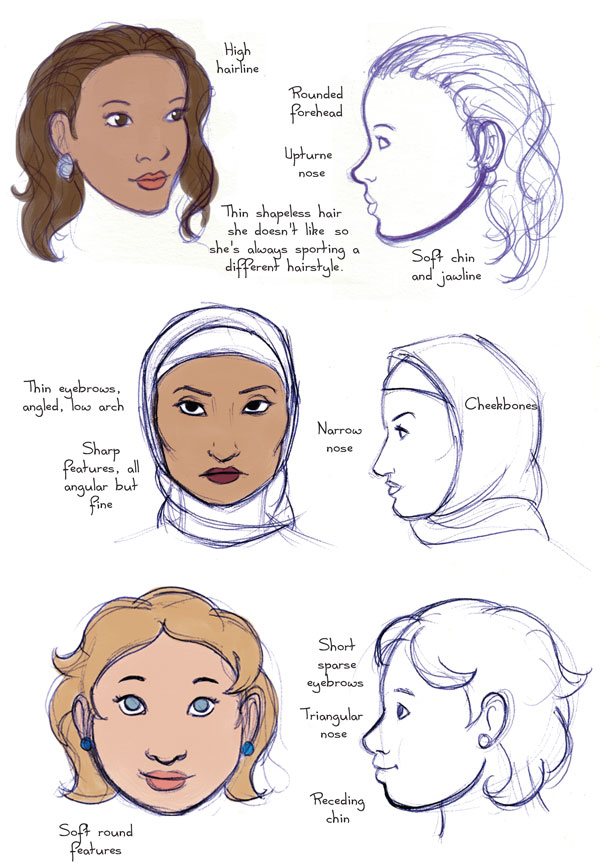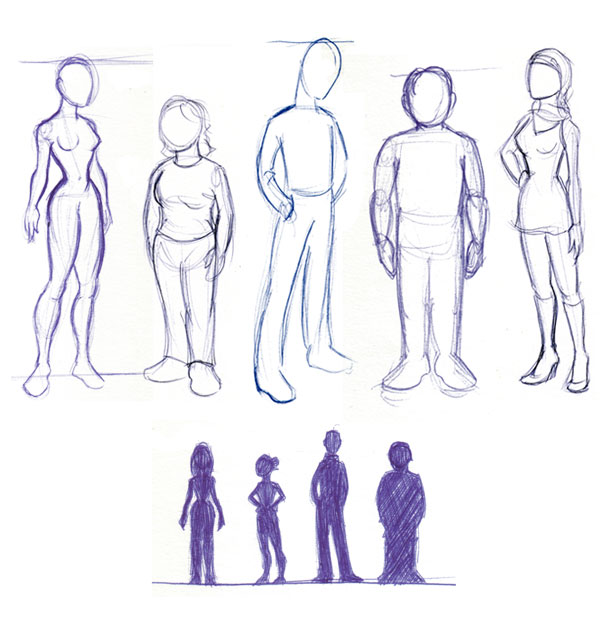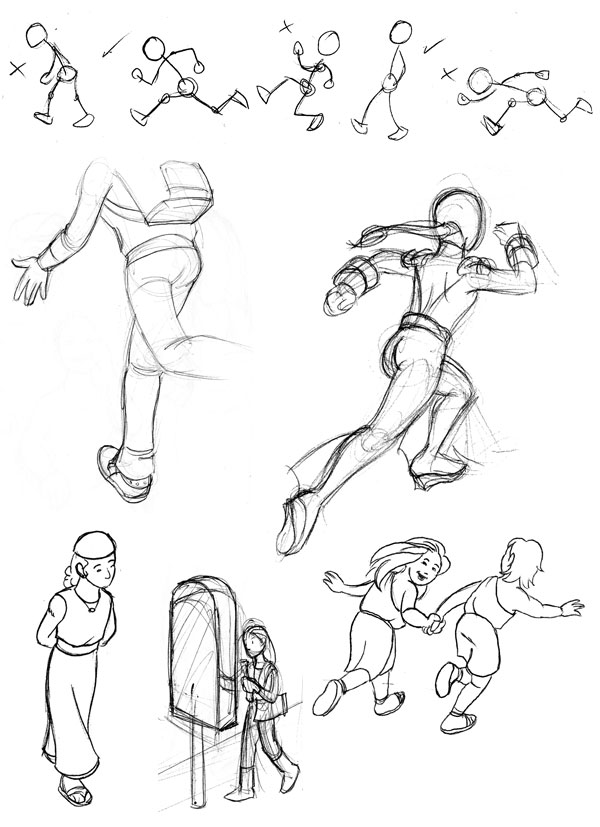
This is the next stage in learning to draw people: being able to draw a person repeatedly, and from different angles, without losing their likeness. It's not an essential skill for all illustrators, but anyone making a story book, or a comic book, or any such project where characters are recurrent, will feel the need for it.
An easy way around it, often used in animated series and older comics, is consistent clothing, i.e the same person always wears the same thing and has the same hair style. This feel old-fashioned and even childish by now, but it's still very common in some manga, and aspiring artists emulating that get into the bad habit of relying completely on hair and clothing to identify people.
What, then, does one do when a character needs to change their outfit? Or in the situation below, different time periods meaning different clothing and hair style, and even the eye colour has changed, yet this is the same person.

1. Know Your Character's Features
Do you know what characterizes your character's features? Or are you drawing generic eyes, noses, and face shapes? This first part doesn't require drawing skills, only being able to really see them in your mind's eye. It's perfectly okay, in the beginning, to base your characters on people you know, while the generic features in your mind get replaced by the diversity of reality.Think of a close friend, someone you can visualize clearly. Can you describe the shape of their nose? Eyes? Mouth? Is their chin protruding or weak? Are their earlobes attached or detached? Odds are you cannot, because you have a general picture of them in mind, but the details break down when you try to look at them closely.
This is easy to change, as you just need to start paying attention to individual features by themselves. Next time you see that particular friend, look closely, and write down what you see. I did say write down, not draw. We cannot keep a grasp on what we can't name. By describing the identifying features that you see to yourself, you make their distinctiveness conscious, and then you know what you're drawing. You can do that in your own head at any time and anywhere, looking at people around you, and it doesn't stop at a person's face, as we'll see below.

Face
The face is naturally where we look for the most amount of details to recognize a person. We have covered this a great deal in Advanced Facial Features. You can use the diagrams from that tutorial, showing different shapes of eyes, noses, lips and faces, to put a name to what you see in real people—and of course you'll find there are even more shapes out there.If you have an old magazine at hand, you can scribble the descriptions right on the photos, as below, training your eye to see them at a glance. It's particularly useful to compare the faces of people of the same gender and age that way, as even if they look alike at first, there are always clues that make them unique. (Bonus points if you try this with people of another ethnicity. The ugly old myth that "all X look alike" is nothing more than unwillingness to look.)

Below are three secondary female characters in my comic. Their very different features betray equally different personalities. Guess who's easygoing, who's a princess and who's a tough cookie?

Hands
While your work may not call for close-ups of hands at all, if it does, then don't neglect this body part, which we have already looked at in detail. Remember male and female hands don't look alike, and further than this, we do tend to be able to recognize the hands of our friends and family. Long fingers, short fingers, fine hands, coarse hands, work-damaged, carefully manicured...
Posture
Have you ever found yourself recognizing someone in the distance by how they stand, or how they walk? Posture is another big clue for identification. We're constantly told we should stand straight, so we may tend to always draw people who stand straight, but in reality there are many degrees of posture. We each have our signature posture, like the characters below, who each stand differently.
Dress style
Note that this is about a person's style, not about a costume. You're not designing one outfit that this person will wear all the time, unless they're in a uniformed profession (policeman, priest) or have a reason to make such a fashion statement. In my comic Malaak, one character, Adrian, always wears the same T-shirt and scarf, accentuating his odd personality... but then we discover there's a reason for it!But while in real life few people wear the same thing day in, day out, most people do have a distinct dress style, and that is something that very much matters in a character. This dress style not only creates consistency, but also conveys much of the character's personality and/or situation.
Students may have a limited wardrobe, while fashion-conscious young women may never be seen wearing the same thing twice. Shy people wear unremarkable clothing, whereas exuberant people get away with the oddest or most visible things. Men usually have a far less diverse array of clothing and colours than women, and so on.
There's plenty of inspiration for designing a dress style, so just observe people around you. A good question to start from could be: Does this person dress for looks or practicality? Do they want to be noticed, or to blend in?
My main character Malaak was raised modestly, and dresses prettily but in a way that doesn't stand out. In contrast, her friend Zeina, who loves attention, always wears something unusual and eye-catching, with good taste decidedly optional. On the other hand Yeraz is an archaeology student by day and trains in Wushu by night—sporty outfits dominate her life at the moment!


Exercise 1
Create a reference/character sheet for a real, existing person. Your grandma, your best friend, a teacher—anyone whom you can enroll for this, and safely stare at and sketch for a while (or take various pictures of for reference).Do it as if you needed to instruct someone else on how to draw that person accurately. Observe, and take note of all that is distinctive about that person: the many details of the face, hair, general silhouette and posture, and dress style, but also essential personality traits, so that your imaginary assistant knows what facial expressions would be in character.
Since this is your first exercise of the sort, don't worry about going overboard with the details. It is with practice and experience that you start cutting down on them effortlessly. Do have fun doing it! As an example, I made this reference sheet of a friend whom I was using as model for my character Adrian. There are many distinct details about him, foremost of which is his almost constant poker face.

Exercise 2
Now do the same, but designing your own character. There is no "correct" way of going about it; you could start with features and derive personality from them, or the other way round, or design the person to go with a certain dress style or role. What's important is that by the time you're done, you know your character's features as if he or she were a real person!Note: Please do not emulate the "character sheets" found on art sites consisting of a single drawing of the character and a wall of backstory and irrelevant details. The purpose of these documents is to know what characters look like to the last detail, not what kind of tea they drink. A good ref sheet is a priceless aid you create for yourself; I pull out all of mine every time I'm working on my comic. Even though I know my characters like old friends, they help me stay true to them even as my style evolves.
2. Know How to Draw Those Features From Various Angles
Once you're fully aware of what is distinctive in your character, it's time to make sure you can draw these traits. This is where, to the question "How can I make my character look right all the time?" the answer is too often "You need to learn to draw."It may sound harsh but really there's no way around it; if one hasn't attained a certain fluency of drawing, if one can't draw simple shapes from different angles, then one cannot realistically expect to succeed in this much more advanced stage. I really do understand the desire to start drawing more exciting stuff (i.e people) straight away, but patience, perseverance and practice are the only road to lifelong results.
Exercise
Use a willing friend again, or if not possible, gather pictures of a celebrity, as they'll be easy to find from many different angles. Focus on just one feature at a time, sketching it from different directions. This needn't be onerous, as you'll notice that some angles are a bit repetitive, and that you can get a good grip on a feature if you have it from front, side, three quarters, above and below. For instance, I started by studying Samuel L. Jackson's nose:




















